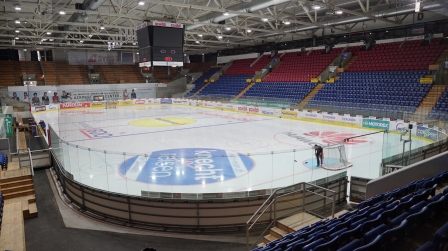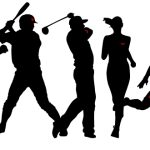Human and machine become one for birth of the Cybathlon
The arena is home to the Kloten Flyers, Switzerland’s leading hockey team, who regularly play to a packed house. But in less than a month, the icy floor inside the country’s largest indoor venue will transform into a race course for a different kind of sporting event. On Oct. 8th, the stadium will open its doors to the world’s first Cybathlon, a multidiscipline competition for people with disabilities who use bionic technologies to augment their bodies.
The Cybathlon will introduce “pilots” with spinal-cord injuries and amputations who will control robotic devices to navigate obstacles in six disciplines. Technologies such as powered exoskeletons, powered prostheses (arm and leg), functional electrical-stimulation bikes, powered wheelchairs and brain-computer interfaces will each get their own race track in the middle of the arena.
Instead of the usual goalposts that stand on each end of the rink, the floor will be set up with a sequence of obstacles along the center for the pilots wearing exoskeletons or prosthetic limbs. Another track will be laid out with machines for the brain-computer interface race. And a bigger racetrack will wrap around the rink for the pilots on bikes.
While the categories within rehabilitative robotics extend beyond the chosen disciplines, the first edition of the Cybathlon focuses on those that currently affect the largest number of people. Years of dedicated research and constant tinkering in labs have slowly brought technology to a point where it can support the most basic movements for people with disabilities. The event is designed to find the technology that touches and improves everyday life for millions who are living with the loss of a limb or are confined to wheelchairs.
The obstacles within each race are carefully built to replicate daily tasks that people with disabilities often struggle to complete and sometimes find impossible to even attempt. For instance, a pilot in an exoskeleton suit will need to walk on different surfaces to win the race. An amputee with a powered leg will be asked to carry a cup of tea and climb a flight of stairs without any support. A powered-arm pilot will have to crack open a jar of jam before spreading it on a slice of bread.
For an able-bodied person, these tasks might seem mundane; they require little to no effort and are often taken for granted. But for a paraplegic man who was told he would never walk again, the task of standing and balancing on uneven surfaces in an exoskeleton suit can be incredibly tedious and near impossible, even with today’s advanced technology.
The Cybathlon is as much a contest of those technological breakthroughs as it is of human strength. Each pilot will be backed by the technical team from the research lab or company that built the technology. “We need the symbiosis,” says Robert Riener, the Cybathlon organizer who has spent the last couple of decades finding and building rehabilitative robotics for people with severe injuries. “The pilot, on one side, needs the technology to be mobile, to perform the tasks. But on the other side, the pilots are the masters; they’re controlling the device. There has to be a careful balance; otherwise, they feel controlled like a technical slave.”
“The idea is to find the best pilots who are able to control technology for the improvement of daily life tasks.” – Robert Riener, Cybathlon organizer
For its unique emphasis on cutting-edge technologies that boost human abilities, the Cybathlon is now popularly known as the “cyborg olympics.” About four years ago, when Riener saw a man with a mind-controlled prosthetic limb scale Chicago’s Willis Tower, he decided there needed to be a competitive space for people who overcome their disabilities with the use of bionic-assistive devices.
Riener started to give that space a concrete shape back in Switzerland. As a longtime professor for sensory-motor systems at ETH Zurich, a leading European science and technology institute, he found himself in a unique position to reach out to a wide network of research labs, standalone developers and commercial giants that make up the field of rehabilitative robotics.
Despite the extensive access, though, he quickly ran into his first challenge: He needed people to take the event seriously enough to start assembling teams, technologies and funding to make it to the final competition. Through a combination of his direct conversations and steady promotions at medical fairs and conferences over a few years, he was able to drum up support and participation from teams across the world. The Cybathlon has 74 competing pilots and their accompanying technical teams from 25 countries.
From a well-established prosthetics company in Reykjavik, Iceland, to a federally funded research lab for spinal-cord-injury patients in Cleveland, the event has pooled the strengths of commercially available technologies and the novelty of experimental solutions. In its global and competitive ambitions, the Cybathlon is comparable to the Olympics and the Paralympics. But the premise is entirely different: Unlike the world’s biggest sporting platforms, which forbid the use of active technologies that enhance performance, the Cybathlon encourages it.
“We allow technology — we have to have technology,” says Riener. “At the Paralympics as well as the Olympics, the goal is to find the best-trained athlete who can perform the fastest and who [is] the strongest. At the Cybathlon, the idea is to find the best pilots who are able to control technology for the improvement of daily life tasks. They also need to be skilled and trained, but they’re training together with the technology.”
The field of robotics has made strides at large but it hasn’t reached a point where it can provide daily comfort and support to the people who need it the most. “There’s still a big need to improve the development of assistive devices for people with motor disabilities,” says Riener. “[…] It’s not visible for the general public because people are a little bit spoiled by Hollywood. The Terminators and Iron Mans. But that technology, which we see on TV, is not yet available.”
Most prosthetic devices continue to be too bulky or fragile for amputees to use freely. A large number of wheelchair options are non-motorized, which tends to get in the way of mobility for spinal-cord-injury users. And the ones that are powered are limited. “That’s why we want to push the development, which has to be done together with the pilots and medical experts,” says Riener. “That’s how we get rid of barriers between developers and people with disabilities. Often developments are being done as separate units. We’re bringing together users who get to benefit [with] the medical experts and the engineers.”
Even as the developers build better solutions, the world isn’t always equipped for these new technologies and the people who use them. From doors that are too narrow for wheelchairs to the taboos that often restrict open conversations around disability, there is a lack of awareness that gets in the way. By bringing people of all abilities together at the Cybathlon, Riener hopes to bring about a change, both in the technology and in public perception.
“We can show the general public what novel technologies are existing and working, but also show what’s not working,” Riener says. “A lot of discussions are going on about including people with disabilities in society, there’s a new conversation about funding and support for them. It’s not just about the technology, but also about acceptance.”
This is the first episode in a five-part video series called Superhumans, which follows the Cybathlon from start to finish. Watch out for the next episode on Tuesday, Sept. 20th, right here on Engadget.
(27)













